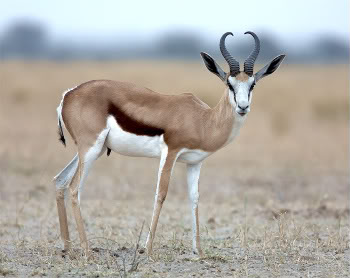The springbok is the only antelope species whose population is on the rise, according to a new review by the Red List for the International Union for Conservation of Nature (IUCN). In addition, over a quarter of the antelopes, 25 species out of 91, are considered threatened with extinction.
“Unsustainable harvesting, whether for food or traditional medicine, and human encroachment on their habitat are the main threats facing antelopes,” says Dr Philippe Chardonnet, Co-Chair of the IUCN Antelope Specialist Group. “Most antelopes are found in developing countries which is why it’s critically important that we collaborate with local communities there since it is in their own interest to help preserve these animals.”
 The critically endangered Hirola. Photo by Tim Wacher. |
The review found that five antelope species are Critically Endangered: the Dama Gazelle , Aders’ Duiker , the Saiga Antelope, the Addax, and the Hirola.
The little-known Hirola is considered possibly the most endangered antelope in Africa. Since 1980 its populations have dropped an astounding 85-90 percent. The Hirola is one of the focal mammals chosen by EDGE for conservation attention. Currently EDGE has a local fellow studying the dwindling populations.
Worse off even than the Hirola is the Scimitar Horned Oryx which is extinct in the wild. There are currently efforts to reintroduce the oryx to its former ranges. Fortunately for recovery efforts, the animal is plentiful in captivity with estimates of over five thousand individuals around the world.
The statement found that if subspecies are included then the findings are even gloomier. Five subspecies are currently considered Critically Endangered: the mountain bongo, the giant sable antelope, the western giant eland, the tora hartebeest, and Congo’s upemba lechwe.
 In the new IUCN report the Springbok is the only antelope species with a rising population. Photo by Pascal Mesochina. |
The statement from the ICUN points out that not all antelopes are in danger. India currently has a good track record with its four native species of antelope with only one considered threatened.
“Despite the pressure of living alongside 1.2 billion people, antelopes are doing well in India,” says Dr David Mallon, Co-Chair of the IUCN Antelope Specialist Group. “It is no coincidence that there is very little tradition of hunting in India and gun ownership is rare.”
While the springbok is the only antelope found to be on the rise, 31 percent of the antelopes’ populations remain stable. 62 percent have a downward trajectory, while not enough data is available for the remaining six percent.
Perhaps ironically, the springbok’s success is mostly due to the game-ranching industry, rather than natural improvement in the wild. They are widely desired for their venison.
Three species of antelope have gone extinct in the last two hundred years: Queen of Sheba’s gazelle, Saudi gazelle (both from the Middle East), and the bluebuck which once inhabited the tip of South Africa.
Related articles
The end of migrations: wildlife’s greatest spectacle is critically endangered
(07/28/2009) If we could turn back the clock about 200 years, one could watch as millions of whales swam along their migration routes. Around 150 years ago, one could witness bison filling the vast America prairie or a billion passenger pigeons blotting out the sky for days. Only a few decades back and a million saiga antelope could be seen crossing the plains of Asia.
Fewer wolves may mean fewer pronghorn in Yellowstone
(03/03/2008)
As western states debate removing the gray wolf from protection under the Endangered Species Act, a new study by the Wildlife conservation Society cautions that doing so may result in an unintended decline in another species: the pronghorn, a uniquely North American animal that resembles an African antelope.
Unprecedented deletion of a World Heritage Site in Oman
(07/03/2007)
The Oryx is one of three or four large antelope species of the genus Oryx, and are known for their long, swept back horns. In 1996 the Arabian Oryx — found on the Arabian Peninsula — numbered 450 within a specially designated area known as the Oman Arabian Oryx Sanctuary. Today, the number sits at only 65, with only 4 viable breeding pairs. Without a doubt, the extinction of the Arabian Oryx in the wild is not out of the question.
Massive wildlife population discovered in Southern Sudan
(06/12/2007)
Aerial surveys by the New York-based Wildlife conservation Society found more than 1.3 million white-eared kob, tiang antelope and Mongalla gazelle in Southern Sudan, despite decades of civil war. The population, which includes more than 8,000 elephants, rivals that of the legendary Serengeti in Tanzania and suggests that the region is of critical importance for conservation efforts.







